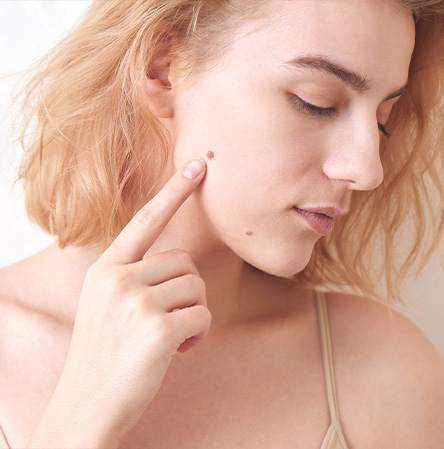- ABOUT US
- CONDITIONS
- TREATMENTS
- Injections
- Botox
- Sculptra
- Topicals
- Sun Protection
- Strong Retinol
- Antioxidants
- Lasers & Devices
- Bela MD Facial
- Intense Pulsed Light (IPL)
- Laser Hair Removal
- Microneedling
- Pinpoint Electrocautery
- Platelet Rich Plasma (PRP)
- RF Microneedling
- Medical Dermatology
- Benign Skin Growth
- Cryosurgery
- Medical Skin Exam
- Gallery
- Pricing
- Contact Us
Quick Links

Not all growths on the skin are cancerous – but, they may still require treatment nonetheless. At Cope Cosmetic Dermatology, our team can help you explore your removal options for clear, smooth skin.
What Are Benign Skin Growths?
Skin growths can come in many different forms, but aren’t always cancerous. Skin growths that are not harmful are called benign. For some people, benign skin growths aren’t bothersome and there’s no need to remove them. However, if you have a benign skin growth that you want to get rid of, a board-certified dermatologist can remove it. In some cases, a benign skin growth can become cancerous and should still be checked by your dermatologist.
Types of Benign Skin Growths
Moles
Although moles are typically associated with melanoma, they aren’t always cancerous. Some people opt to have moles removed for cosmetic or comfort reasons if a mole is large, visible, or sticks out.
Warts
Warts are caused by a minor HIV infection when it comes into contact with a cut or scrape in the skin. They’re more common on the hands and feet in people who have weaker immune systems (like children).
Skin Tags
Skin tags are small, skin-colored growths that occur in areas like the neck, armpits, or groin. They are very common and easily removed with a variety of treatments.
Seborrheic Keratoses
Seborrheic keratoses are more common in older patients and look like small, wart-like spots. They can be flesh-colored, brown, or black and are usually oval or round.
Lipomas
Lipomas are soft bumps under the skin caused by a small deposit of fat. They’re more common in women and are usually located on the forearms, torso, or neck.
What Causes Benign Skin Growths?
There are many different types of benign skin growths, and each can have a different cause. In general, skin growths are caused by an overabundance of cellular activity. For example, skin tags are typically caused by an overgrowth of skin cells whereas moles are caused by a group of melanocytes (or pigment cells) that cluster together. Some people are more likely to experience skin growths than others, but some types of benign skin growths (like moles) are incredibly common.
What Are My Treatment Options for Benign Skin Growths?
Your treatment plan can depend on your type of skin growth. It’s important to determine whether your growth may be cancerous or not, and a board-certified dermatologist can perform a skin check to make sure. Then, you can discuss your treatment plan from a variety of options:
- Cryosurgery
- Surgical Removal
- Laser Removal
- Intense Pulsed Light (IPL)
- Pinpoint Electrocautery
Each procedure can be performed in-office with a local anesthetic during a quick and easy session. You’ll discuss the specifics of your treatment plan during your consultation.
Maintaining Healthy Skin with Benign Skin Growths
It’s important to take care of your skin according to aftercare instructions when having a benign skin growth removed. This includes keeping the area clean and covered, as well as protected from the sun. Unfortunately, many types of benign skin growths can’t be prevented – however, your dermatologist can easily remove them as needed.

DR. AUSTIN COPE, MD, MBA
Born and raised in Utah, Dr. Austin Cope is a highly trained and passionate cosmetic dermatologist dedicated to helping you age gracefully. At Cope Cosmetic Dermatology, our team is here to ensure that you not only look your best but also feel confident and empowered in your own skin.
SCHEDULE AN APPOINTMENT
Ready to feel more like yourself again? Dr. Cope combines expert care with a relaxed, personal approach to help you age gracefully and regain your confidence. Let’s create a personalized plan just for you. Reach out through our online form or give us a call.
385-273-1007 SCHEDULE

